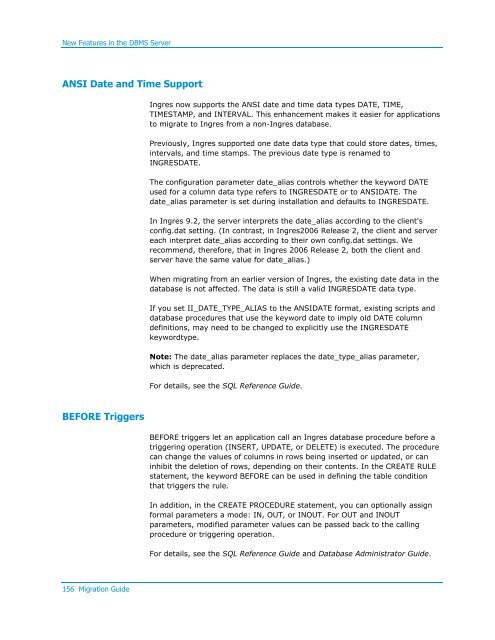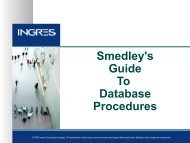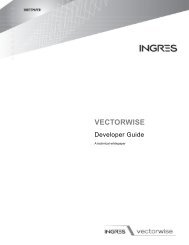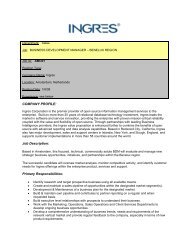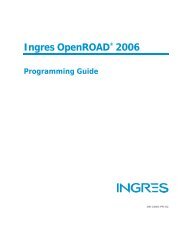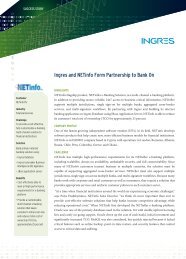Ingres 9.2 Migration Guide - Actian
Ingres 9.2 Migration Guide - Actian
Ingres 9.2 Migration Guide - Actian
You also want an ePaper? Increase the reach of your titles
YUMPU automatically turns print PDFs into web optimized ePapers that Google loves.
New Features in the DBMS ServerANSI Date and Time Support<strong>Ingres</strong> now supports the ANSI date and time data types DATE, TIME,TIMESTAMP, and INTERVAL. This enhancement makes it easier for applicationsto migrate to <strong>Ingres</strong> from a non-<strong>Ingres</strong> database.Previously, <strong>Ingres</strong> supported one date data type that could store dates, times,intervals, and time stamps. The previous date type is renamed toINGRESDATE.The configuration parameter date_alias controls whether the keyword DATEused for a column data type refers to INGRESDATE or to ANSIDATE. Thedate_alias parameter is set during installation and defaults to INGRESDATE.In <strong>Ingres</strong> <strong>9.2</strong>, the server interprets the date_alias according to the client'sconfig.dat setting. (In contrast, in <strong>Ingres</strong>2006 Release 2, the client and servereach interpret date_alias according to their own config.dat settings. Werecommend, therefore, that in <strong>Ingres</strong> 2006 Release 2, both the client andserver have the same value for date_alias.)When migrating from an earlier version of <strong>Ingres</strong>, the existing date data in thedatabase is not affected. The data is still a valid INGRESDATE data type.If you set II_DATE_TYPE_ALIAS to the ANSIDATE format, existing scripts anddatabase procedures that use the keyword date to imply old DATE columndefinitions, may need to be changed to explicitly use the INGRESDATEkeywordtype.Note: The date_alias parameter replaces the date_type_alias parameter,which is deprecated.For details, see the SQL Reference <strong>Guide</strong>.BEFORE TriggersBEFORE triggers let an application call an <strong>Ingres</strong> database procedure before atriggering operation (INSERT, UPDATE, or DELETE) is executed. The procedurecan change the values of columns in rows being inserted or updated, or caninhibit the deletion of rows, depending on their contents. In the CREATE RULEstatement, the keyword BEFORE can be used in defining the table conditionthat triggers the rule.In addition, in the CREATE PROCEDURE statement, you can optionally assignformal parameters a mode: IN, OUT, or INOUT. For OUT and INOUTparameters, modified parameter values can be passed back to the callingprocedure or triggering operation.For details, see the SQL Reference <strong>Guide</strong> and Database Administrator <strong>Guide</strong>.156 <strong>Migration</strong> <strong>Guide</strong>


